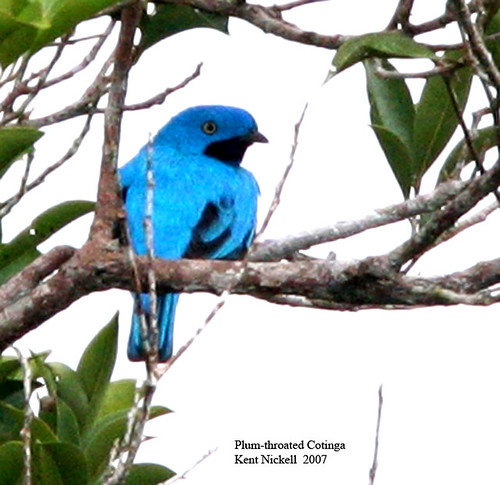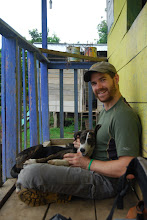
photo by: Will Minehart
Although the weather has been quite variable since arriving here, ranging from forty degrees one morning, then eighty-five the next, our clothes are usually damp with sweat about ten minutes after taking off for our morning’s work as the sun is just breaking the horizon. We usually hike a few kilometers each morning, sometimes as much as ten, as we move from site to site up the trail, stopping at the yellow flags we have placed on small saplings, denoting the presence of another antbird’s territory.
We move through the forest playing these birds’ songs, waiting for them to come flying in to defend their territory. They flit through the understory, shaking their wings and calling back in defense of their home, but little do they know we are only crying wolf, at least today.
In the coming days, the antbirds hear the phantom intruder again, and usually fly in with equal vigor to dispatch the threat. As they dart around in search of the intruder, an invisible hand sweeps out from the void, and suddenly they are hanging, still able to move and flop around in the air they were just flying through a minute earlier, but very few escape.
Watching from afar, we see the net jump, and a black ball of netting forms where the bird struggles in vain. We turn off the speakers singing the song of the phantom intruder, and move in to collect the bird from the net. This usually takes a minute, but sometimes it can take longer, depending on a multitude of ways a bird can rarely become severely tangled. Usually removing a bird entails holding onto both feet after you have untangled the thin netting from its claws, then simply backing the bird out of the net as you remove the loops of netting that have slid over the two wings first and then finally the head. In perfect instances like this, you are left with a bird sitting indignantly atop your fingers as you hold its legs.
However, if nets are not set to the appropriate tension, there are sticks pushing against them for the birds to grab hold of, or it gets tangles around the bird’s tongue, which is forked in the back of their throat, the results for the bird are potentially grim. To an amateur, a snared bird looks hopelessly entangled, and death seems immanent short of cutting the bird free. In reality, removing the bird is relatively simple, but I do recall one time during a hot day in Pennsylvania when a tiny wren had been overlooked in one of our nets where it was tangled on the ground. In the time it took me to find the exhausted bird, it had become extremely tangled, and it had been laying in the direct sunlight.
I struggled for some time, talking to the bird to calm my racing heart. Carefully rolling the bird around in my hands as I searched for the easiest place to begin, I thought of the family of wrens I watched grow up in a bird-box in my neighbor’s lawn one summer. At that moment, holding that bird in my sweating hands, I questioned the rationale of such invasive research practices. Stopping several times, I allowed the bird to hang in the net again as I took a few breathes and looked around me in exasperation as if some help might materialize from the briars surrounding us.
I eventually unraveled the hundreds of strings imprisoning the bird, and an hour later I set the wren in the shade of a raspberry bush. I came back thirty minutes later to find it still sitting there, but as I leaned in for a better look, it flitted away through the brush. Every time I take hold of a bird’s legs as it hangs in the net, I remind myself to remain calm so as to minimize any possibility of worsening this tenuous situation.
These mist-nets are amazing contraptions, and are ironically of very similar texture and density as those lunch ladies or even you may have worn if you have ever worked in the food industry. When hung properly they are virtually indistinguishable in the early morning light. We always chuckle on the trail when one of us gets caught or literally walks right into the net moments after setting it up. We then know we have set a good net, and despite being completely black, you have to focus hard to discern it from the rest of the forest.

photo by: Frances Buerkens
National Geographic and other such organizations have done an amazing job of glorifying the sexiest parts of science and field research, but as many people say, it is really far from glamorous or exciting. Amidst days that can easily feel downright lethargic and unrewarding, work that is initially illuminated with inspiration can easily become obscured within the shadows of this dark and humid rainforest.
The nature of this work makes it very difficult to aptly describe. It would be easy to romanticize this research, only describing the most attractive parts of the position, but it would shed no light on the basic reasons why there are people out here doing this in the first place.
Even the actual act of recording data is so anally structured that you are often too stressed and focused on collecting data in the correct way that you fail to even take enjoyment in the fact that you are holding a living creature in your hand. When else do we ever come into direct contact with a living wild animal?
Holding a bird, I can barely feel its almost nonexistent papery weight. Just flip a fifty-cent piece in the air. This is all that these creatures weigh. The beating of their heart sends a slight vibration through my hand. Their head follows my fingers, snapping back in defense the moment I put them within reach. You can feel the texture of each feather as softly as a whisper in your ear, and you can see how the pattern on each contributes perfectly to the whole.

photo by: Will Minehart
This is the reason I began this work. So long ago I sat in my yard, staring at robins. I never realized then, as they hopped around in the lush summer grass, plucking long worms from nowhere that they would never be interested in the seed placed conspicuously beneath the box sitting in the middle of the yard that was propped up by a stick with a string tied to it. Why I spent so many hours staring out from behind the shed in my yard, holding onto the other end of that string in vain still makes no more sense to me than the subconscious driving attraction I feel in the midst of a beautiful woman. It is never enough to simply see when attraction is concerned. Some internal force yearns for more, driving me to touch, to reach out and affirm the physical existence of such beauty as though to only see without touch can still leave its existence in question. A feather found shining in the light dappling the trail brings out the voyeuristic side in many of us. I know many who find it impossible to pass by a fallen feather without picking it up. Some of us hide them in books, removing them from time to time to admire their brilliant color and to feel their softness against our cheeks. Others adorn their cars or rooms with such ornaments of refuse, and despite their timely fading in the sun, they still shiver in the wind when the windows are down and the music loud.
However, these are not the thoughts that cross my mind as I hold calipers up to the beak of these petite kites with hearts. I do not feel any realization of my ultimate attraction as I hold a capillary tube to the vein of this tiny bird to collect a sample of its meager blood supply as it lies helplessly in my sweaty hands.
I sometimes question, rather every time we catch a bird, the stress I perceive us imparting on it forces me to question this work. But as I see a sheepish smile spread over one of the other researchers I am working with as he holds up one individual to closer inspect this species plumage patterns, I see a glimmer of passion in his eyes that reminds me what it felt like to finally hold a live bird after so many years of senseless attraction and even obsession with this distant beauty.
In such passion there is a pure love present that is both selfish and benevolent. For every time I look into the eyes of a bird in my hands I see a smile spread across the face of that three year old I used to be, hiding behind that shed in the yard I grew up in, hoping that the string in my hand attached to the trap thirty feet away would eventually turn into the reality of a bird in my hands. However, in those eyes I also see the frail reminder of the responsibility I feel within my chest to protect the world that makes it possible to feel the reality of this little feathered dream.
So, when people ask me to describe what I do on a daily basis, especially now when I am so far from home in the Amazon, I find it hard to answer them clearly. I am going out into the jungle every day, finding where specific birds are located, catching them, putting little identification bands on their legs, and then extracting all the data I can from each bird just shy of taking its life. This is all in the name of science, and in this particular project it is to hopefully gain more insight about exactly how one single species can diverge into many, even though they may live a kilometer or only a couple hundred meters away from each other.
I hate snagging a bird out of the air, smashing its supreme grace with an invisible net, and I doubt anyone doing this work enjoys extracting the integrity from a bird as it lies supine in their hand, bleeding slightly from a vein in their elbow so that we can later compare its DNA to their relatives'.
Nonetheless, at the moment this is one of the very few methods we have to gain the vital knowledge necessary to testify to the intrinsic value and need for conservation that most people doing this work feel moved to be a part of. For me, it is the only way I have found possible to exact some societal value to my life while still achieving the dreams of that kid who still stares with hope from the depths of my memory.

photo by: Will Minehart
































